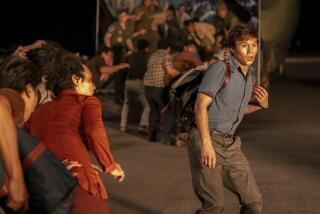Country’s Least Attractive City Trying to Put on a New Face
VINH, Vietnam — It hasn’t been easy for this drab port city, but Vinh is trying to gussy itself up to attract tourists and foreign investors and shed the burdens of its wartime history.
Bombed periodically by the French between 1931 and 1952, Vinh was devastated by the Americans, whose air raids from 1964 to 1972 razed all but three buildings: a provincial guest house and two college dormitories.
“If you’d come here 25 years ago, all you’d have seen was a pile of bricks,” said Ngo Van Yem, an official with the local People’s Committee. “We had to build a new city. From the ground up.”
So perhaps what is most noteworthy about this city that East Germany helped rebuild is not that Vinh is known as Vietnam’s least attractive city, but that it survived at all. Except for some antiaircraft gunners, its population in 1972 was zero. Now it numbers 220,000, and, although Vinh lags behind other urban areas in terms of development, there are signs, however subtle, of economic progress.
Vinh, 190 miles south of Hanoi, and its port were bombed round the clock in the mid-’60s because the city was the main supply point for the Ho Chi Minh Trail, the web of paths and roads that North Vietnam used to move equipment and fighters to South Vietnam’s battlefields. Locals still refer to Vinh as “the throat that fed the stomach.”
“I can tell you exactly when the first American plane came,” said Nguyen Van Ngoc, 71. It was Aug. 5, 1964. “We’d been bombed before by the French, and when I saw the American planes, I said, ‘Uh-oh, here we go again.’ ”
Vinh’s hopes of attracting tourists or investors received a setback last year when Vietnam Airways canceled its Hanoi-Vinh flights because of lack of demand, leaving the city’s airport idle save for three flights a week to Danang on a propeller-driven plane.
But the university is operating again, there’s a new bank in town, the wide streets are congested with bicycles, and the port is being upgraded. It bustles with ships carrying logs from Laos to Japan and with vessels bringing secondhand electronics from South Korea and Taiwan to Vietnam.
The 74-room Nuu Nghi Hotel has had a face lift, and the local chef has spruced up the menu with new selections that include chicken testicles with ginger, sauteed frog with banana and turtle with leg of pork. (The turtle dish is not in great demand, and the main course splashes around its tank, awaiting the inevitable.)
To maintain standards, regulations are posted in each hotel room. No. 7 warns: “No harboring the social evils: prostitution, gamble, criminal.” (Social evils, however, are widely said to be available in the massage parlor off the ground floor.) No. 8 advises: “The hotel just taken upon oneself about guests money and wealthies when both of sides are having the transfer between the guest or receptionist or room servant.”
“We’re still struggling with English,” said Nguyen Sy Thuy of Nghe An province’s Foreign Relations Department. “When I was young, we all learned Russian or German. I even studied in East Germany. Today, the children are offered French or English in school. They all choose English.”
East Germany, a staunch supporter of North Vietnam during the war against the United States, rushed in to help Vinh as soon as the bombing stopped in 1972. Its first contribution was the construction of 21 five-story concrete apartment buildings for 6,000 workers. Named the Quang Trung quarters, for an 18th century Vietnamese emperor who routed Chinese invaders, the complex included kindergartens, schools, even a supermarket.
But no one thought about maintenance, and when the Soviet bloc collapsed, Bonn showed little interest in supporting the project, which today has all the appearances of a slum. The buildings are falling apart, electrical wires protrude from stairwells, plaster drops from apartment ceilings. Rents for the best units are $3.50 a month, and all are full.
“It’s a problem, no doubt about it,” said Nguyen Van Luc, a People’s Committee member who is working on Vinh’s new master plan. “We’ve talked about razing Quang Trung, but if we can get the money, what we’d like to do is renovate. You can’t just make 6,000 people homeless.”
The master plan pins its hopes on attracting foreign investment to Nghe An province and on promoting tourism to capitalize on two nearby attractions: the three-room thatched-roof home where Ho Chi Minh was born in 1890 and the down-market beach town of Cualo, a popular summer destination for Vietnamese vacationers.
More to Read
Sign up for The Wild
We’ll help you find the best places to hike, bike and run, as well as the perfect silent spots for meditation and yoga.
You may occasionally receive promotional content from the Los Angeles Times.






